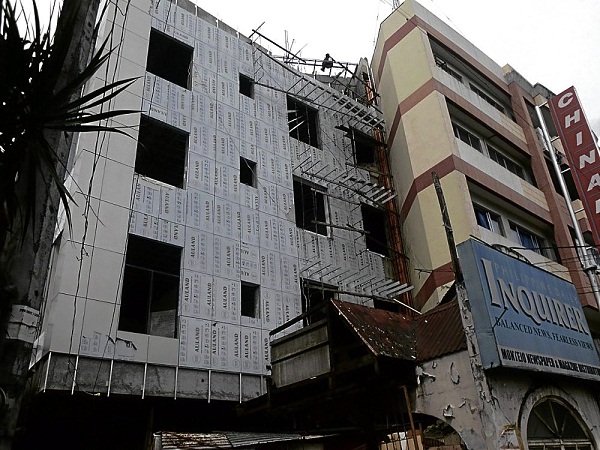
THE FAMILY of An Waray Rep. Neil Benedict Montejo is building a five-story hotel on Imelda Street in Tacloban City, Leyte. Photo by Joey A. Gabieta
TACLOBAN CITY, Leyte—Tacloban City’s skyline is changing. At least 156 commercial buildings, including a shopping mall, restaurants and hotels, have sprouted in the capital over the past three years, more than double the number in 2008.
The construction boom is an indication that Tacloban, a gateway to Leyte province, is no longer a sleepy city known only as the hometown of former First Lady and now Ilocos Rep. Imelda Romualdez-Marcos.
Tacloban’s growth and bustling economy have been propelled by tourism and retail industries.
“People are discovering Tacloban. If Robinson’s is there, there must be something,” said Cynthia Nierras, regional director of the Department of Trade and Industry. Robinson’s Place opened a branch in the city in 2010.
The shopping mall serves as a magnet for other businesses, which soon recognize Tacloban’s attractive market with its increasing population and spending power, Nierras said.
Robinson’s Land Corp. also built Go Hotels in Tacloban, a 98-room hotel just beside the mall.
Hotel projects
According to Nierras, Tacloban and the rest of Leyte have been enjoying increased tourist arrivals, and local hotels have difficulty accommodating booking requests.
Nierras said at least four investors had visited her office to inquire about putting up hotels.
In 2010, 74 commercial buildings worth P122 million were built, according to records at Tacloban City engineering office. The next year, 61 more, with a total cost of P180 million, were constructed. As of July this year, 21 other buildings were going up.
Some of the new buildings will house food establishments and companies that have main branches either in Metro Manila or Cebu.
“The rise of several commercial buildings across Tacloban is a welcome development as it is a testament that it is a growing city,” said businessman Jerry Uy, legal officer of the Filipino-Chinese Chamber of Commerce and Industry’s Tacloban chapter.
“With the competitiveness of the business environment nowadays, businesses are left with no option but to construct new buildings or lease space in newly constructed buildings in strategic locations in the city,” Uy said.
Suppliers
The construction boom also benefited dealers of building materials in terms of increased sales.
“Our sales of construction materials, notably cement, have increased between
10 and 20 percent,” said Reynaldo Chua, owner of Ever Hardware.
Rodolfo Padillo, a former president of the Tacloban Contractors Association, said the ongoing construction projects “generate the much-needed employment for our people and even those coming from nearby areas.”
One project, he explained, would require the hiring of laborers, numbering from a hundred to 1,000, depending on its size.
Both the regional offices of the Department of Labor and Employment and the National Statistics Office, however, do not have data on how many jobs have so far been created.
“If you see new buildings rising, it only means one thing: There is really a construction boom here in Tacloban,” Mayor Alfred Romualdez said.
He said this development would be good for the city government since it would generate revenues, aside from providing employment opportunities.
In 2010, the city government earned P6.37 million in building fees and another P6.20 million in 2011, records from the City Treasurer’s Office showed.